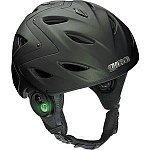|
Ski Helmets, Instructor’s TipsWearing ski helmets is not compulsory, but absolutely no one can argue that they are a bad idea.Helmets save lives and make our favorite past time a whole lot safer. And no matter what we tell people at the bar after the ski day, we all fall at some point. If you don't fall, you're not pushing the limits. Falling is fun.
Ski helmets are not mandatory. It's completely your choice on whether you're going to protect your head from an injury. There's no telling when you might hit your head – hucking a cliff, ripping a groomer, skiing switch, ripping the trees, slashing the bumps, walking to the car… Ski helmets haven't always been the cool things to wear, but in the last five years or so the number of skiers that wear helmets has exploded. Helmets are much more comfortable than they used to be. They no longer limit your visibility or affect your ability to hear (unless you're listening to music). Instead they are comfortable, lightweight, low profile, warm, ventilated, and safe. In fact when you wear a helmet that fits properly, you may not even remember that you're wearing a helmet at all. Helmets can prevent head injuries. Nobody wants to be a vegetable because they knock their head on the snow, but it happens regularly at ski resorts across the country. And it's easy to limit your chances of a head injury by wearing a helmet. The really great thing about helmets is that they are being built and designed by bunches of companies like Boeri, Giro, Smith, Bern, Red, P.O.C., K2, Pro-Tec, Salomon, and others. This means you'll be sure to be able to find a helmet that fits your head and style. All of these companies send their helmets through a variety of tests to ensure that the helmet is safe and meets any and all standards. The first step in buying a ski helmet is to find one that fits your head. Take a tape measurer and measure your head just above your eyebrows. Record the size in centimeters. The next step is to go to the store and try them on. Be sure to find a helmet that fits snugly. You should be able to shake your head and the helmet won't move too much. It shouldn't be too tight either. Once you find a helmet that you think fits your head, wear it around the ski shop for five or ten minutes to make sure it fits as well as you think. If the helmet fits well after a few minutes, try it on with your goggles. Make sure your goggles fit comfortably. Tighten and loosen them to get a good fit. Some helmets fit goggles better than others. Adjust your goggles before each helmet you try on. You may be surprised at how adjustable your goggles are. After all this, you still need to pick what color helmet you want. And they come in every color from black and white to stripes and plaids. You can even get them with compatible earphones, which are like a home theater system for your ski world, but please be careful listening to music while you ski. Helmets come in so many different styles, don't worry about not being able to express your individuality.
Every single year, helmet technology gets better. After a few years, it's probably in your best interest to upgrade your helmet. You'll get better protection, a new style, and you'll feel like you are safer when you ski your favorite terrain. What it comes down to is –ski helmets rock. Watch any ski movie that comes out, all the pros are wearing them, kids have grown up skiing in helmets, and when you visit your local resort you most likely see more helmets that beanies. Plus helmets have been proven to save lives. It would be silly not to wear a helmet.
|





